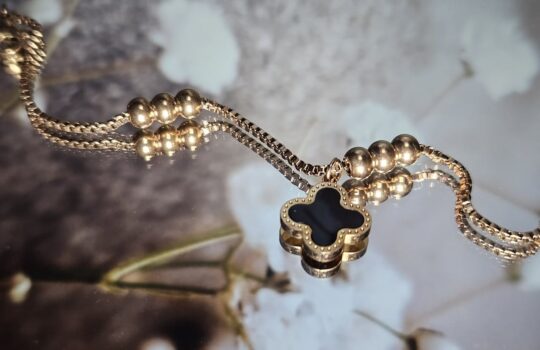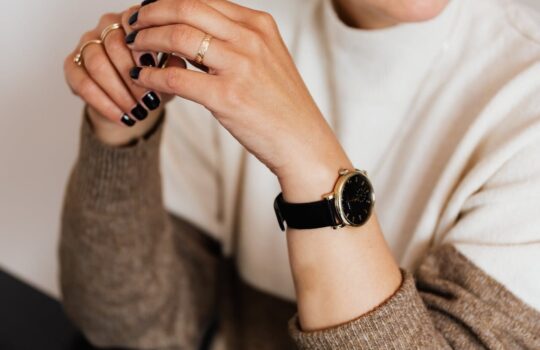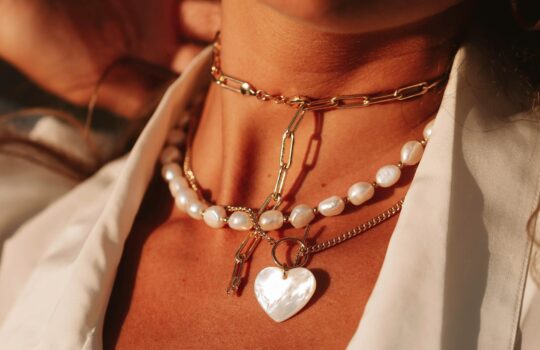Hypoallergenic Metals: Which Earrings & Jewelry are Best for Sensitive Skin
Sensitive skin can sometimes take the fun out of wearing earrings, belly rings that you love. You might buy lovely jewelry that turns your earlobes red, splotchy and painful on your first wear. This an indication that your skin may be allergenic to the metal in your jewelry. Jewelry crafted from hypoallergenic metals may solve this problem.
In this post, we'll explain the types of metals are hypoallergenic and share our hand-picked lost of the best earrings for sensitive ears.

What is Hypoallergenic Jewelry?
Hypoallergenic jewelry is made of metals that are not likely to cause allergic reactions. People typically have allergies to different metals - we are all quite different - but, nickel allergy is the most common, causing allergies in 15% of the population. Nickel is one of the many additives used to reinforce softer metals like gold and silver, as metals used in jewelry typically alloys - a mixture of metals combined for added strength.
There is no set criteria to define what makes jewelry hypoallergenic since this depends on a persons type of allergy and how severe the allergy is to be given this label. However, for jewelry to be considered as hypoallergenic, it must contain little to no nickel to cause a skin reaction. Therefore, understanding which types of metals may cause a reaction, may significantly help you know which type of metal is the safest for your skin.
Therefore, whenever you see jewelry being described as "hypoallergenic", you can check the metal content to make sure the combination won't irritate your skin.
Hypoallergenic jewelry is not necessarily more expensive, but most high quality metals are lower in nickel content and less likely to cause a reaction. For instance, you may find that your skin only reacts to heavy nickel content in costume jewelry and not the small percentage of nickel used in 14k gold jewelry. Jewelry with a slight nickel percentage is not harmful to most people.
What it a Nickel Allergy?
If you have a nickel allergy, you skin might react by turning red and tender, and develop dry patches or possibly blisters where it comes in contact with nickel.
Earlobes, and other piercing sites are a common place to experience contact dermatitis from nickel in jewelry because the skin is thin or soft. Nickel allergy affects about 15% of females, and 2% of males. Nickel and nickel allergy isn't just limited to just jewelry; it can also be found in everyday items like keys, door knobs, clothing buttons and belt buckles. Prolonged exposure to nickel can increase sensitivity, potentially leading to nickel allergy later in life.
"Jewelry should elevate your style, not irritate your skin. Hypoallergenic jewelry lets you enjoy the beauty of adornment, free from worry and discomfort.”
Is Nickel-Free Important?
If your skin is sensitive to metal, buying nickel-free jewelry is important to protect your skin. For majority of the population, the 85%, a small percentage of nickel is safe, but those with nickel allergy should avoid wearing jewelry with heavy nickel content. For the sake of clarity, if you have a skin reaction of any jewelry, its important to see a dermatologist to determine if you have a nickel allergy or some other type of metal.
For those highly sensitive to nickel, keep in mind that some jewelry be may described as "nickel-free", a tag to the plating of the metal but not the metal itself. Therefore, when the plating wears off, the Jewelry will no longer be nickel-free.
What Metals Are Hypoallergenic?
The Best Hypoallergenic Metals
We selected the top three metals we consider the best hypoallergenic jewelry based on what is beautiful, most widely available, and high-quality.
- Rhodium-plated sterling silver
- Nickel-free sterling silver
- Platinum
Is Rhodium Hypoallergenic?
Yes, Rhodium is one of the best hypoallergenic metals. Rhodium jewelry is typically found in sterling silver plated in rhodium. Any other metal can be rhodium-plated, but nickel-free sterling silver is the best hypoallergenic option. Rhodium is a lustrous, high-quality metal that contains no nickel. A such, not matter the base metal, rhodium-plating offers protection against a reaction to nickel. However, keep in mind that plating can wear out with time and needs to be replaced, so its important to ensure that the base metal is hypoallergenic as well to maintain protection against nickel allergy.
Is Sterling Silver Hypoallergenic?
Yes, Sterling Silver jewelry is often hypoallergenic - often, as sterling silver is an alloy containing mostly silver in addition to other metals that add strength to pure silver. Therefore, some sterling silver jewelry is nickel-free, depending on its composition.
Here are the details of silver commonly used in jewelry:
- 925 Sterling Silver, is the most popular choice for fine jewelry and is composed of 92.5% silver, 7.5% other metals, usually copper. Nickel can be used in sterling silver, but for most people, a small percentage this is not a cause for concern. The appearance of pure silver but its more durable dye to the added metals.
- 999 Fine Silver is softer and more malleable than sterling silver, making it less suitable for everyday wear as it's prone to scratching and bending. Fine silver is composed of 99.9% pure silver.
- Argentium Silver is more tarnish resistant than traditional sterling silver, making it a popular choice for jewelry as it requires less maintenance. It is available in two grades, 93.5% silver and 96% silver, with the remaining percentage made up of germanium and copper.
- Coin Silver, historically was used for making coins hence the name Coin Silver, composed of 90% silver and 10% copper. This alloy is found in vintage or antique jewelry pieces, but less common these days.
- Mexican Silver, produced in Mexico, is slighter purer than sterling silver and is known for its craftsmanship and detailed designs. It's composed often of 95% silver, 5% other metals, typically copper.
- Britannia Silver, historically used for coins in Britain but now used in some high-end jewelry pieces. Its purer than sterling silver with 95.8% silver, 4.2% other metals (usually copper) but still durable enough for jewelry.
All in all, genuine sterling silver will tarnish because of its copper content, but that is solved with regular cleaning and wear.
What is 952 Sterling Silver?
925 is the mark of authentication in genuine American Sterling Silver, describing the percentage of silver content at 92.5%. Typically jewelry made from 925 sterling silver may also contain the markings like STER, SS or ST. Low quality silver jewelry with a smaller percentage likely has higher nickel content. Therefore, stick to genuine sterling silver containing 92.5% silver, 7.5% copper and possible other metals like zinc or nickel. Nickel-free is a great sterling silver jewelry is a good hypoallergenic option.
Is Platnimum Hypoallergenic?
Yes, Platinum is hypoallergenic and quite an expensive metal option for jewelry. Infact, it is one of the most luxurious metals known for its durability and resistance to tarnish. It is a popular choice for engagement rings, fine jewelry that are meant to last a lifetime. When platinum is combined with other metals for jewelry, nickel does not make a cut. It's commonly combined with other hypoallergenic metals like ruthenium, iridium, and cobalt to create a strong alloy, that results in the perfect combination of purity, strength and comfort for those with sensitive skin. Therefore, platinum's hypoallergenic properties remain even when alloyed with other metals.
Is Stainless Steel Hypoallergenic?
No, but its a great metal to wear if you don't have a metal allergy or very mild nickel sensitivity.
Here is the kicker, stainless steel is a very popular metal due to its durability, resistance to corrosion and ability to retain its shine over time. It remains an excellent choice for those without a severe nickel allergy or with only mild nickel sensitivity. However, stainless steel isn't hypoallergenic because it contains nickel, even if only in small amounts.
Here is a brief explanation breaking down the different stainless steel options used in jewelry, including the different types:
- 316L Stainless Steel, also called surgical steel but with lower carbon content. It contains 16-18% chromium, 10-14% nickel, and about 2-%molybdenum. 316L is better for sensitive skin due to its lower nickel content.
- 316 Stainless Steel, an alloy made up of 16-18% chromium and 10-12% nickel. It's durable, resistant to corrosion and heat and retains a shiny finish. However, due to the significant nickel content, it may not be suitable for people with nickel allergies.
- 304L Stainless Steel contains approximately 18-20% chromium and 8-12% nickel. Just like 316L, 304L contains low carbon content and is widely used in making jewelry. Its also durable, corrosion-resistant but has a higher nickel content than 316L, making it less suitable for those with nickel sensitivities.
- 204L Stainless Steel, added manganese, contains about 16-18 chromium, 1-2% nickel. It's more affordable due to the lower nickel content, which is replaced by manganese - however its less corrosion-resistant than 316L and 304L, and while it may bet better for those with mild nickel sensitivity, its not fully hypoallergenic.
Stainless steel is durable, retains its shine well and is resistant to corrosion and heat. This makes it a great choice for people with an active lifestyle. Overall, though the nickel content in stainless steel is small, its durable, chemical resistant and quite affordable.For those with sensitive skin, 316L stainless steel/surgical steel is the best option due to its lower nickel content - though not entirely hypoallergenic.
Is Gold Hypoallergenic?
Yes, Gold in 24k is considered hypoallergenic due to its high purity. However, it is also too soft for everyday jewelry.
To enhance golds durability, other metals like nickel, copper or silver are added to it, to create stronger alloys suitable for jewelry. The purity variation of gold alloys come with 14k and 18k gold, with 18k containing a higher percentage of pure gold than 14k. Therefore, if you have a mild nickel sensitivity, 14k gold may still be wearable as it contains a small amount of nickel. If irritation persists, consider 18k gold or just go for 24K gold or other hypoallergenic metals like platinum or titanium for severe sensitivity.
Rose gold is another hypoallergenic, made from a blend of pure gold and copper, which gives it a warm, pinkish. It doesn't contain nickel, making it skin-friendly alternative to traditional gold alloys.
Is Vermeil Hypoallergenic?
No, Vermeil features a base of sterling silver, plated with a thick later of 18k gold. While sterling silver is hypoallergenic, vermeil jewelry is not ideal for sensitive skin because of the 18k gold later which often contains some traces of nickel (around 8-10%) which may still cause irritation to those with nickel allergies. For a jewelry piece to be considered vermeil, the gold plating must be at lease 2.5 microns thick and typically with 14k, 18k, or even 24k gold.
All in all, though sterling silver is hypoallergenic, the presence of nickel in the gold plating makes gold vermeil less suitable for those with very sensitive skin - particularily at 14k and 18k gold plating.
Learn More: A Guide to Gold Jewelry: Gold Plated, PVD Gold, Vermeil, Gold-Filled & Solid Gold
Is Titanium Steel Hypoallergenic?
Yes, Titanium is hypoallergenic and an excellent choice for those with sensitive skin or metal allergies. Titanium is an alloy, which contains aluminum and vanadium, not nickel - a common allergen. This makes titanium an excellent choice for daily wear without causing irritation.
Titanium has many other benefits. It is also corrosion resistant, meaning it can withstand exposure to saltwater or chlorine, making it ideal for wearing in the ocean or pools without tarnishing or degrading. Additionally, its a lightweight, extremely durable metal that is resistant to scratches and damage. In fact, it is said to be three times stronger than steel, making it an excellent choice for that want jewelry that will last a lifetime, even in demanding conditions.
With titanium though, there is a trade off - because titanium is so strong its challenging to craft in elaborate designs and for rings, its difficult to resize.
Is Copper Hypoallergenic?
Yes, generally copper is hypoallergenic unless it is reinforced with nickel. Copper allergies on the other hand do exist but are rare. Brass, which is combination of cooper and zinc is hypoallergenic. However, neither cooper nor brass are high quality, and their lower cost sacrifices longevity. Both copper and brass turn skin green - a characteristic of the metals, not an allergic reaction.The green is as a result of oxidation, copper's reaction to sweat or chemicals. It’s not pretty, but it is harmless to your skin.
If Your're Allergic to Earrings or other jewelry, Here is what you do:
If you are allergenic to earrings or other jewelry, here are some steps you can take to avoid irritation and enjoy wearing jewelry again:
- Avoid Cheap Costume Jewelry: Costume jewelry is often cheap and made of base metals like nickel, which is an allergen. Invest in a high quality pieces made from hypoallergenic metals. Though may cost you a pretty penny upfront, they'll be much gentler to your skin and will last longer than costume jewelry.
- Visit Your Dermatologist: If you experience any skin irritation from jewelry, visit a dermatologist. A doctors visit will help you to establish whether you have a nickel allergy, or any other metal, or if you have another condition such as contact dermatitis. Its important to identify the root cause of your irritation and find the best treatment plant to protect your skin.
- Choose Nickel-Free Jewelry: Avoid nickel if you have a nickel allergy/sensitive skin and focus on purchasing nickel-free jewelry. Metals like titanium, platinum, rhodium or gold are excellent choices. Purge your collection of any pieces containing nickel and invest in some good high-quality pieces that you can wear comfortably.
- Opt for Hypoallergenic Metals: Look for jewelry crafted from hypoallergenic metals such as titanium, platinum, or sterling silver. These metals are less likely to cause reaction are safe for sensitive skin.Surgical grade stainless steel (316L) is also a good choice for those with mild sensitivities, as it contains trace amounts of nickel that are less likely to irritate the skin.
By taking these steps, you can protect your beautiful skin from allergenic reactions caused by nickel and continue to ensure your jewelry without any worry.
The Best Jewelry For Sensitive Skin
At Haute Haus, we curate high quality titanium, rhodium, stainless steel jewelry, sterling silver and most of our pieces are hypoallergenic or contain trace amounts of nickel. We love high performance jewelry because we understand our customers lead an active lifestyle - therefore, they need jewelry that is safe for sensitive skin, corrosion resistant, durability without compromising on designs.
When it comes to jewelry, we curate jewelry inspired by trends and culture. We seek to offer an entire collection devoted to high-performance jewelry we love and hope you enjoy them as much as we do.





